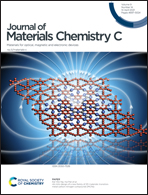Triphenylamine/benzothiadiazole-based compounds for non-doped orange and red fluorescent OLEDs with high efficiencies and low efficiency roll-off†
Abstract
Long-wavelength materials are key for development of pure-color and white organic light-emitting devices (OLEDs). An organic molecule, combining hybridized local electron and charge-transfer (HLCT) states and aggregation-induced emission (AIE), not only breaks the 5% external quantum efficiency (EQE) limit but also overcomes emission quenching. Herein, we designed and synthesized four novel donor–acceptor compounds of TBAN, TBT, TBAT, and TABAT using triphenylamine (TPA) as the donor, benzothiadiazole (BT) as the acceptor, and anthracene (AN) as a bridge. We found that the emission peaks of TBAN, TBT, TBAT and TABAT are located at 596, 615, 580 and 546 nm, respectively. We successfully applied them to non-doped OLEDs, and the resulting devices exhibited excellent performance. For example, the optimal TBAN-based OLEDs showed a maximum luminance of 74 820 cd m−2, a current efficiency of 12.1 cd A−1 and a maximum EQE of 5.7% with low roll-off. Additionally, the device with TBAN as both the emitter and hole-transport material also exhibited high efficiency that is comparable to that of an NPB-based device. This work demonstrates that it is feasible to obtain excellent orange and red emitters by employing BT- and TPA-based D–A architectures.



 Please wait while we load your content...
Please wait while we load your content...
